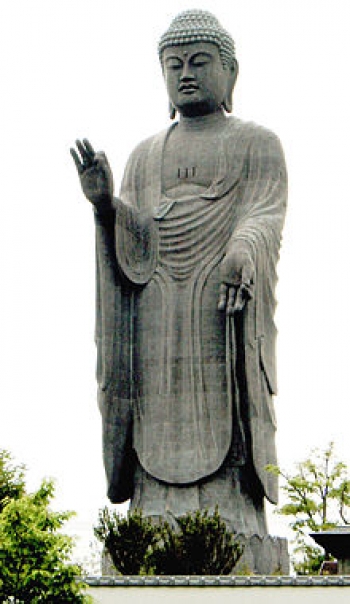Although the Pratyutpanna Sutra (which describes a fairly advanced form of Pure Land practice) came to China from India sometime in the first century of the Common Era, it was not until some four hundred years later that Pure Land Buddhism became a focus of attention due to the intense interest of a monk Huiyuan, the first Pure Land Patriarch. Huiyuan was originally a Taoist scholar who sought immortality. Of course, he sadly found that nobody he knew lived over the age of eighty!
We cannot be absolutely sure how Huiyuan came across the Pure Land Sutras nonetheless they ignited his interest as they spoke of another transcendence that was beyond just physical mortality. They spoke of a transcendence of all suffering, an ending of the not-so-merry-go-round of birth and death, and a life after this mortal life of ours in a place called the Land of Ultimate Bliss. It is in this land that one could progress towards Nirvana without having to come back in human or animal form again.
Huiyuan thus became a monk, though a Ch’an monk, but later gained permission from his Abbott to set up his own movement devoted to attaining freedom from suffering in the Pure Land.
The principle practice of Pure Land Buddhism is the meditation on the figure and name of Amidha Buddha, the Buddha of never ending Life and Light and on the oral reciting or chanting of the Buddha’s name – in Chinese Amituo Fo. The Pure Land practice parallels Zen Buddhism in that its aim is to empty the mind of all thought and attain awakening and union with pure being, Thusness.
However, perhaps the major sticking point for many newcomers to Pure Land Buddhism is the belief in the existence of another place called Pure Land. Is it nothing more than just a Buddhist Heaven, similar to the Christian ‘heaven’? Was the Lord Buddha speaking only figuratively when he described in great and minute detail the landscape of Pure Land as is recorded in the Visualization Sutra and the Amitabha Sutra? Many Pure Land practitioners today tend to stay clear of ‘the Pure Land exists’ idea and settle for Pure Land being in one’s own mind.
I’m not sure I agree.
Shakyamuni Buddha was a careful and precise teacher and was not prone to speaking figuratively. If he were speaking only in these terms then how much more of the Sutras do we need to reshape? Do we need to reinvent Buddhism for our modern era? It was not long ago in our world history that the world was considered to be flat. Many suffered torture for believing otherwise. My own mother was ridiculed by her friends when she used to “dream” of human beings one day going to the moon. I recall dearly the day as the world sat glued to their TV screens to watch that momentous event of man landing on the moon and small tears rolling down my mother’s eyes and my father holding her, deeply apologizing for having laughed at her years before.
In recent world history we have placed a probe on Mars and there is the likelihood of life form on this planet. We have begun to punch into the outer reaches of our galaxy and it is more than possible that there be other planets containing life form similar to ours. Who would be the first to deny this?
I would like to explore, in my next piece, what this means for our understanding of a “Pure Land”.
Part 2















